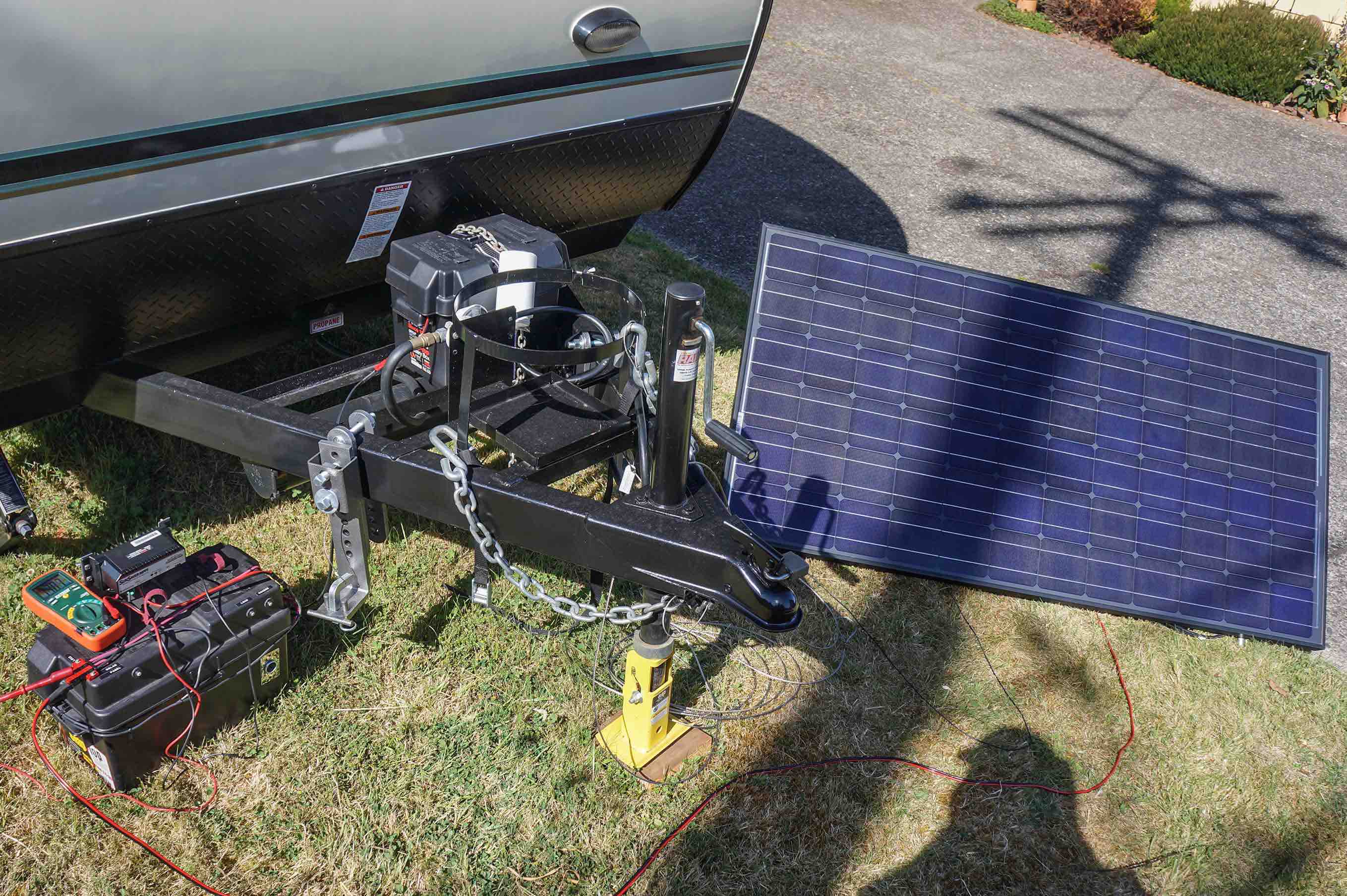
 |
|
Post Reply 
|
Page <1 89101112 14> |
| Author | |
sailor323 
Senior Member 
Joined: 11 Jun 2015 Location: S Central KY Online Status: Offline Posts: 281 |
 Topic: Connecting a 100 watt solar panel to Zamp port Topic: Connecting a 100 watt solar panel to Zamp portPosted: 20 Jun 2016 at 2:38pm |
Minuscule is not strong enough word, negligible would be better. |
|
 |
|
WillThrill 
Senior Member 

Joined: 04 Jul 2014 Online Status: Offline Posts: 298 |
 Posted: 22 Jun 2016 at 11:31pm Posted: 22 Jun 2016 at 11:31pm |
Moon glow is not sufficient to produce any output for a solar panel. It might produce just enough to register on a multi-meter, and probably a very sensitive one at that, but not enough for any usable purpose. Heck, the lights in your house aren't strong enough to power a normal solar panel, so there's no way that the moon will. Solar panels don't work when it's cloudy, rainy, or at night.
|
|
|
"Not all those who wander are lost." Tolkien
2014 Hood River 177 2005 GMC Envoy XL |
|
 |
|
JandL 
Senior Member 

Joined: 29 Mar 2014 Location: California Online Status: Offline Posts: 364 |
 Posted: 22 Jun 2016 at 11:52pm Posted: 22 Jun 2016 at 11:52pm |
|
The moon does not produce its own light, it reflects light from the sun
|
|
|
JandL
2013 Honda Ridgeline 2012 177 2 Paynes in a Pod |
|
 |
|
Don Halas 
Senior Member 
Joined: 01 Jul 2015 Location: Connecticut Online Status: Offline Posts: 190 |
 Posted: 23 Jun 2016 at 10:20am Posted: 23 Jun 2016 at 10:20am |
|
I never suspected it would produce anything of use, just curious if the suns reflection from the moon was sufficient enough to be 'recognized' by the panels.
|
|
 |
|
JandL 
Senior Member 

Joined: 29 Mar 2014 Location: California Online Status: Offline Posts: 364 |
 Posted: 23 Jun 2016 at 11:02am Posted: 23 Jun 2016 at 11:02am |
|
From Wikipedia
"The intensity of moonlight varies greatly depending on the lunar cycle but even the full Moon typically provides only about 0.1 lux illumination, bright sunlight is 111,000 lux" |
|
|
JandL
2013 Honda Ridgeline 2012 177 2 Paynes in a Pod |
|
 |
|
furpod 
Moderator Group - pHp 
Joined: 25 Jul 2011 Location: Central KY Online Status: Offline Posts: 6128 |
 Posted: 23 Jun 2016 at 11:48am Posted: 23 Jun 2016 at 11:48am |
In large arrays, like for a cabin or home, this is how it is done.. with one caveat.. They are not running a "12v" system. You use a higher voltage sytem from the get go. Most home/cabin, etc installations run at 48v. Some at 24. Depends on the total load allowed for. This could be done with an RV.. but not real easy in the confines of a Pod. Quality higher input/output inverters also get expensive quick.
Next time I am over in Menonite country, I will get a picture of one of their systems running my favorite country store/bakery... It's a 48v system built on Group 8D batteries in series. Just the battery bank is big as a Pinto..
|
|
 |
|
WillThrill 
Senior Member 

Joined: 04 Jul 2014 Online Status: Offline Posts: 298 |
 Posted: 26 Jun 2016 at 8:15pm Posted: 26 Jun 2016 at 8:15pm |
|
A 48 volt system would basically require a completely new electrical system: new converter/charger, new refrigerator capable of running on 48 volts, new water heater, new water pump, new fan, new sound system. In the context of an RV, I can't find a good reason to do all of that, and you would need a minimum of four 12 volt batteries linked in series (not easy to do on the tongue of a Pod).
If you're talking about an off-grid cabin, it can make sense to go with a 48 volt system, but not in an RV. With multiple solar panels on an RV, you would simply connect them in parallel to maintain 12 volt (nominal) output. This has the advantage of not bringing down the whole array if one panel gets shaded or something on the panel itself like a bird dropping, a serious concern for solar arrays wired in series. True, you need heavier gauge wire with parallel wiring, but in an RV, the amperage and distances aren't a big concern anyway.
|
|
|
"Not all those who wander are lost." Tolkien
2014 Hood River 177 2005 GMC Envoy XL |
|
 |
|
Rustler 
Senior Member 
Joined: 07 May 2016 Location: S. Oregon Coast Online Status: Offline Posts: 100 |
 Posted: 27 Jun 2016 at 2:50am Posted: 27 Jun 2016 at 2:50am |
John, with a higher voltage solar array you are quite correct that the current would be lower at the same power rating. This does have advantages in having lower voltage drop (and lower power loss) with a given power output and wire size. Consider two examples:
For a given wire gauge the setup in example 2. could go twice as far with the same voltage drop. You get a further advantage in that the percentage voltage drop would be 1/2 since it is based on 25 volts, not the 12 volts of example 1. Now to get that advantage, you don't need to wire two panels in series. They make higher voltage solar panels that are used in high voltage DC systems or in grid tied systems. For instance I have a 36 volt, 185 watt panel made for a grid-tied solar system. It puts out around 5.1 amps at 36.4 volts. With that panel I can have less than 3% voltage drop with 10 gauge wire running 75 feet. Here's a good link to a handy voltage drop calculator. The good news is that you do NOT have to run your camp trailer at the higher voltage. A maximum power point tracking controller (MPPT) runs at the higher voltage for maximum efficiency, lower power/voltage loss in your wiring. But it then conveniently does a voltage conversion to provide for charging a 12-volt battery. In clear text you can use a 36 volt panel to charge a 12-volt battery with a MPPT controller. A 36 volt panel can be found with a diligent search on the internet. They are actually quite common, many thousands being made for the grid-tied market. Here's an example of such a panel at a reasonable price: Back to the example of my 185 watt panel. Between the solar panel and controller, the voltage is around 36 volts at 5 amps. From the controller to the battery the voltage is between 12 and 14.7 volts depending on the battery charging needs. Current into the battery is up to 15 amps. Since the MPPT controller is mounted on the battery box, the panel can be up to 75 feet away (with 10 gauge wire). The higher current, low voltage line running from controller to the battery is around a foot long, with minimum voltage/power loss. Here's a photo of the 185 watt panel, MPPT controller and battery. I'm sorry that the photo is so enormous. I can't seem to get it small enough to view the whole thing without scrolling left and right.  The charge controller is a Morningstar SSMPPT-15L. It runs around $225. But considering the advantages of a high voltage panel, the extra cost is well worth it. I hope that my thoughts here will be of use, John. If you have any questions, let me know. I would be pleased to be of help. |
|
|
Russ
2009 Toyota RAV4 V6 w/ tow package 2016 Rpod 171 HRE |
|
 |
|
Don Halas 
Senior Member 
Joined: 01 Jul 2015 Location: Connecticut Online Status: Offline Posts: 190 |
 Posted: 27 Jun 2016 at 7:40am Posted: 27 Jun 2016 at 7:40am |
|
Rustler, someone did their homework.
Nice work. |
|
 |
|
WillThrill 
Senior Member 

Joined: 04 Jul 2014 Online Status: Offline Posts: 298 |
 Posted: 09 Jul 2016 at 11:55pm Posted: 09 Jul 2016 at 11:55pm |
|
A little bump considering that many questions have arisen about this topic lately.
|
|
|
"Not all those who wander are lost." Tolkien
2014 Hood River 177 2005 GMC Envoy XL |
|
 |
|
Post Reply 
|
Page <1 89101112 14> |
| Forum Jump | Forum Permissions  You cannot post new topics in this forum You cannot reply to topics in this forum You cannot delete your posts in this forum You cannot edit your posts in this forum You cannot create polls in this forum You cannot vote in polls in this forum |